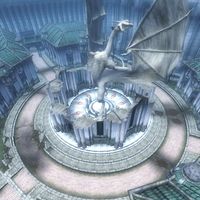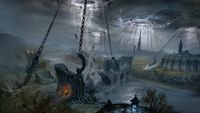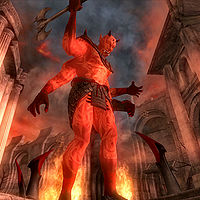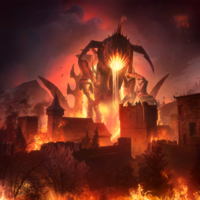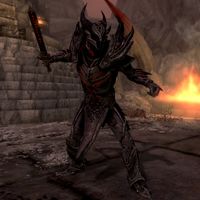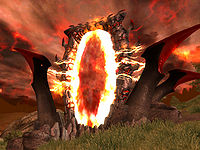Lore:Liminal Barriers
The Liminal Barriers, sometimes singularized as the Liminal Barrier, are the dimensional barriers between the Mundus and Oblivion. These barriers were powered by the Dragonfires, mystical fires maintained by Akatosh as part of his covenant with Saint Alessia.[1][2][3] However, after the events of the Oblivion Crisis, the barriers have been permanently shut forever by Akatosh, making the Dragonfires obsolete.[1] The liminal barriers serve to prevent Daedric invasions and to keep the Mundus safe. Despite this, the liminal barriers are not impenetrable, and have weakened numerous times. Usually, this weakening occurs when the pact between Akatosh and mortals is violated, and the Dragonfires are extinguished.[4][5] Besides these instances, the liminal barriers are also known to have varying strength, which can affect how long transliminal portals can remain open.[6]
Contents
Invasions[edit]
Numerous Daedric invasions have occurred over the course of Tamrielic history, due to the pact between Akatosh and mortals being temporarily broken. These include:
The Planemeld[edit]
The Planemeld was a monumental Daedric invasion of Tamriel that took place in 2E 582, during the Interregnum. The Daedric Prince Molag Bal used Dark Anchors, huge Daedric interplanar machines of his own design, in an attempt to drag Nirn out of Mundus and into his realm of Coldharbour. Rifts of darkness that lead from Tamriel directly to Coldharbour appeared across the continent. Each death in Tamriel weakened the barriers between Nirn and the realms beyond, and the concurrent Three Banners War only accelerated the Planemeld. The scale of the Planemeld is comparable to that of the Oblivion Crisis. The Planemeld was ultimately stopped by the Vestige with Meridia's assistance.
The Oblivion Crisis[edit]
The Oblivion Crisis, also known as the Great Anguish, was a total war between Mehrunes Dagon's Daedra hordes and the population of Tamriel. It began with the assassination of Uriel Septim VII and all of his known heirs in 3E 433.
Shortly afterward, Oblivion Gates to the Deadlands opened across Tamriel and Daedra poured out as the result of a fanatical cult of worshippers of Mehrunes Dagon known as the Mythic Dawn. Widespread devastation and casualties resulted across entire provinces. The Daedra besieged Skyrim, and laid waste to the Old Holds. In Black Marsh, the Hist called back many Argonians to fight off the Daedra. According to An-Xileel the Daedra were forced to close their Oblivion gates in Black Marsh due to an Argonian counter invasion. In Cyrodiil, the city of Kvatch was entirely destroyed.
Vonos[edit]
In 4E 201, the Mythic Dawn cultist Vonos performed a profane ritual involving the Dovahkiin to open an Oblivion Gate in Skyrim. Despite the gate permanently opening, the planned invasion by the Daedra was foiled when the Dovahkiin ventured into the portal, slew the generals of the invasion force, Valkyn Methats and Valkyn Gatanas, and took their weapons, Torment and Scourge.[7]
Invitations[edit]
Although the liminal barriers prevent Daedric invasions, they do not altogether prevent Daedric presence on Nirn. This is because mortals may invite Daedra into the Mundus by summoning them or opening portals.
- Despite the strength of the liminal barriers, practitioners of Conjuration magic regularly crack open the doors of Oblivion to summon lesser Daedra to do their bidding. However, summoning greater Daedra runs the risk of making the crack impossibly difficult to shut.[8]
- Oblivion Gates are portals opened between Nirn and Oblivion using Sigil Stones. These are gates that connect to Daedric realms based on the realm of origin of the Sigil Stone, and may last for minutes at a time.[6]
- Additionally, while Daedric invasions are prevented by the liminal barriers, this does not mean the Daedra can't be summoned en masse by mortals. One such attempted instance is The Culling by Lord Naarifin.[9]
- In the year 1E 2920, both Molag Bal and Mehrunes Dagon were directly summoned to Nirn to destroy cities. Molag Bal destroyed the town of Gil-Var-Delle upon request of the then mad King of Senchal, Dro'Zel. Similarly, Mehrunes Dagon destroyed Old Mournhold upon the request of Turala, a witch of the Skeffington Coven.[10] These Princely summonings were banned by the Coldharbour Compact, a deal between multiple Daedric Princes and the Tribunal god Sotha Sil.[11][12]
Gallery[edit]
-
A Storm Atronach being summoned through the use of Conjuration magic
-
Lord Naarifin attempting to begin The Culling
Notes[edit]
- The Moonlight Blade had the ability to cut through the liminal barriers.[13][14]
- According to Demiprince Fa-Nuit-Hen, Slipstream Realms are transitional realms between Mundus and Oblivion where "transliminal forces balance in standing waves", with the Battlespire Academy being within one of these realms.[15]
See Also[edit]
References[edit]
- ^ a b Events of Light the Dragonfires in Oblivion
- ^ Dialogue from the Drake of Blades in ESO
- ^ Trials of St. Alessia
- ^ The Prophet's dialogue in ESO
- ^ Vonos' Journal — Vonos
- ^ a b Liminal Bridges — Camilonwe of Alinor
- ^ Events of The Consequences in Skyrim
- ^ The Improved Emperor's Guide to Tamriel: The Summerset Isles: Auridon — Flaccus Terentius, 2E 581
- ^ Events of The Showdown in Legends
- ^ 2920, The Last Year of the First Era — Carlovac Townway
- ^ The Coldharbour Compact
- ^ Sotha Sil's dialogue in ESO: Clockwork City
- ^ Shando-ri's dialogue in ESO: Elsweyr
- ^ Vastarie's dialogue in ESO: Elsweyr
- ^ Lord Fa-Nuit-Hen and Tutor Riparius Answer Your Questions — Fa-Nuit-Hen and Tutor Riparius
